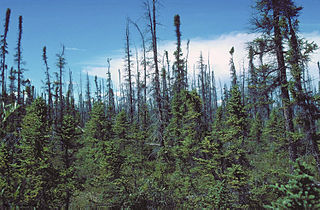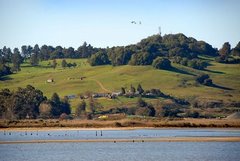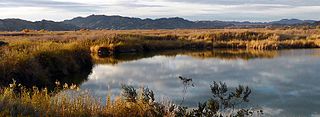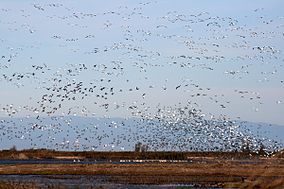
Benton Lake National Wildlife Refuge is a 12,459-acre (5,042 ha) National Wildlife Refuge (NWR) in the central part of the U.S. state of Montana.
Bowdoin National Wildlife Refuge is a 15,551-acre (6,293 ha) National Wildlife Refuge (NWR) located in the north-central region of the U.S. state of Montana. The refuge is 7 mi (11 km) northeast of Malta, Montana in the Milk River Valley and is managed by the U.S. Fish and Wildlife Service.

The boreal forest or taiga of the North American continent stretches through a majority of Canada and most of central Alaska, extending spottily into the beginning of the Rocky Mountain range in Northern Montana and into New England and the Adirondack Mountains of New York. This habitat extends as far north as the tree line and discontinues in mixed deciduous-coniferous forests to the south. The "taiga", as it is called there, of Eurasia occupies a similar range on those continents. Throughout the Northern Hemisphere, the boreal forest covers 2.3 million square miles, a larger area than the remaining Brazilian Amazon rain forest. Although it is largely forest, the boreal forests include a network of lakes, river valleys, wetlands, peat lands and semi-open tundra.

The fauna of Toronto include a variety of different species situated within the city limits. Toronto contains a mosaic of ecosystems that includes forests, rivers, streams, and wetlands, which allows it to support a large variety of fauna. Approximately 90 per cent of animals that inhabit the city reside within the Toronto ravine system. The city's ravine system, creeks and rivers are wildlife corridors that allow animals to travel from one area of the city to another. Although most animals in Toronto reside within the ravine system, several animals also live in the city's urban environment and parks.
The San Luis National Wildlife Refuge Complex is located in the northern San Joaquin Valley, within Merced County and Stanislaus County of California. The complex, with four federal National Wildlife Refuges, is managed by the U.S Fish & Wildlife Service.

Shollenberger Park is a 165-acre (0.67 km2) wetland park located in Petaluma, California. Together with the 80-acre (320,000 m2) Alman Marsh, and 260-acre (1.1 km2) Ellis Creek which opened to the public in July 2009, a total of 505 acres (2.04 km2) are accessible to the public. The entirety is referred to as the "Petaluma Wetlands".

The Imperial National Wildlife Refuge protects wildlife habitat along 30 miles (50 km) of the lower Colorado River in Arizona and California, including the last un-channeled section before the river enters Mexico. The Imperial Refuge Wilderness, a federally designated, 15,056-acre (60.93 km2), wilderness area is protected within the refuge. It also surrounds the Picacho State Recreation Area. This section of the Colorado River is popular for boating, hiking, fishing, camping, exploring old mining camps and wildlife watching.

The Delevan National Wildlife Refuge is one of six refuges in the Sacramento National Wildlife Refuge Complex in the Sacramento Valley of central northern California.

Kankakee Sands is a 10,000-acre (4,000 ha) restored tallgrass prairie in Kankakee County, Illinois and Newton County, Indiana. It is managed by The Nature Conservancy staff and volunteers. The Efroymson Restoration at Kankakee Sands is 8,400 acres (3,400 ha) of prairies and wetlands connecting Willow Slough Fish and Wildlife Area, Beaver Lake Nature Preserve, Conrad Savanna Nature Preserve and Conrad Station Savanna. This creates over 20,000 acres (8,100 ha) of dry, mesic and wet sand prairies, sand blows, sedge meadows, wetlands, and black oak savannas.










